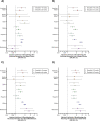Race/ethnicity-specific associations between breastfeeding information source and breastfeeding rates among U.S. women
- PMID: 36932332
- PMCID: PMC10024358
- DOI: 10.1186/s12889-023-15447-8
Race/ethnicity-specific associations between breastfeeding information source and breastfeeding rates among U.S. women
Abstract
Background: Despite evidence of the impact of breastfeeding information on breastfeeding rates, it is unknown if information sources and impact vary by race/ethnicity, thus this study assessed race/ethnicity-specific associations between breastfeeding information sources and breastfeeding.
Methods: We used data from the 2016-2019 Pregnancy Risk Assessment Monitoring System. Race/ethnicity-stratified multinomial logistic regression was used to estimate associations between information source (e.g., family/friends) and breastfeeding rates (0 weeks/none, < 10 weeks, or ≥ 10 weeks; < 10 weeks and ≥ 10 weeks = any breastfeeding). All analyses were weighted to be nationally representative.
Results: Among 5,945,018 women (weighted), 88% reported initiating breastfeeding (≥ 10 weeks = 70%). Information from family/friends (< 10 weeks: aORs = 1.58-2.14; ≥ 10 weeks: aORs = 1.63-2.64) and breastfeeding support groups (< 10 weeks: aORs = 1.31-1.76; ≥ 10 weeks: aORs = 1.42-2.77) were consistently associated with breastfeeding and duration across most racial/ethnic groups; effects were consistently smaller among Alaska Native, Black, and Hispanic women (vs White women). Over half of American Indian and one-quarter of Black women reported not breastfeeding/stopping breastfeeding due to return to school/work concerns.
Conclusions: Associations between breastfeeding information source and breastfeeding rates vary across race/ethnicity. Culturally tailored breastfeeding information and support from family/friends and support groups could help reduce breastfeeding disparities. Additional measures are needed to address disparities related to concerns about return to work/school.
Keywords: Breastfeeding; Health disparities; Maternal and Infant Health; PRAMS; Race/Ethnicity.
© 2023. This is a U.S. Government work and not under copyright protection in the US; foreign copyright protection may apply.
Conflict of interest statement
The authors declare no competing interests.
Figures


References
-
- Rates of Any and Exclusive Breastfeeding by Sociodemographics among Children Born in 2018. National Immunization Survey, Centers for Disease Control and Prevention, Department of Health and Human Services. https://www.cdc.gov/breastfeeding/data/nis_data/rates-any-exclusive-bf-s.... Accessed 19 Jan 2023.
-
- Rates of Any and Exclusive Breastfeeding by Sociodemographics Among Children Born in 2017. National Immunization Survey, Centers for Disease Control and Prevention, Department of Health and Human Services. https://www.cdc.gov/breastfeeding/data/nis_data/rates-any-exclusive-bf-s.... Accessed 19 Jan 2023.

